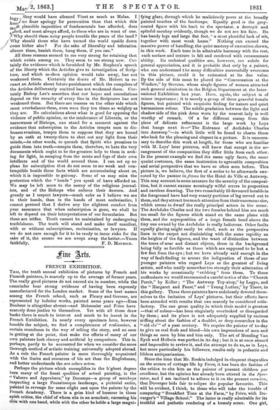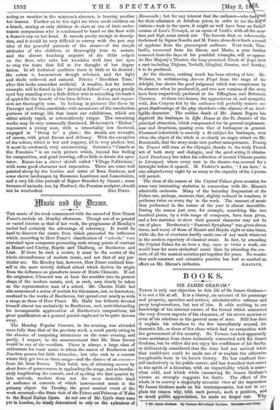l int A rt s.
FRENCH EXHIBITION.
Tuts, the tenth annual exhibition of pictures by French and Flemish painters, is scarcely up to the average of former years. The really good pictures do not exceed six in number, while the remainder bear strong evidence of having been expressly manufactured for the London market. Some of the best names among the French school, such as Fleury and Gerome, are represented by inferior works, painted some years ago—Rosa Bouheur is altogether absent—and Meissonier and Frere have scarcely done justice to themselves. Yet with all these draw backs there is much to interest and much to be learnt in the French Exhibition. In nearly every specimen here, however humble the subject, we find a completeness of realization, a certain roundness in the way of telling the story, and an ease in getting at the point, that make the efforts of many of our own painters look clumsy and artificial by comparison. This is, perhaps, partly to be accounted for when we consider the more thorough method of artistic training universally adopted abroad. As a rule the French painter is more thoroughly acquainted with the limits and resources of his art than the Englishman, and better understands the ars celare artem.
Perhaps the picture which exemplifies in the h'ghest degree here many of the finest qualities of actual painting, is the " Valuers and Appraisers," by Decamps—a group of monkeys inspecting a large Poussinesque landscape, a pictorial satire, painted in revenge for some slight cast upon the painter by the French Academy. There is a grim kind of humour in these apish critics, the chief of whom sits in an armchair, caressing his shin with one hand, while with the other he holds a large magni-
fying glass, through which he maliciously peers at the broadly painted touches of the landscape. Equally good is the grey- coated figure with his back to the spectator, a decrepit and spiteful monkey evidently, though we do not see his face. He has bandy legs and large flat feet, "a most plentiful lack of wit, together with most weak hams." Nothing can exceed the massive power of handling, the quiet mastery of execution shown, in this work. Each tone is in admirable harmony with the rest, each surface and texture is felt and rendered with consummate ability. Its technical qualities are, however, too subtle for general appreciation, and it is probable that only by a painter, who can understand the many difficulties successfully overcome in this picture, could it be estimated at its due value. By the side of this must be placed the " Conversation at the Window," by Stevens, whose single figures of women attracted such general admiration in the Belgian Department at the Inter- national Exhibition last year. Here, again, the subject is of minor importance ; it is merely a group of three graceful female figures, but painted with exquisite feeling for nature and quiet harmonious colour. The subtle gradation between the light and shadow side of the pink dress worn by the nearest lady is well worthy of remark. Of a far different stamp from this piece of delicate refinement is the large work by Leys that hangs next it—" The Entrance of Archduke Charles into Antwerp "—in which little will be found to charm those who look for the pleasing and elegant in a picture. It is unneces- sary to describe this work at length, for those who are familiar with M. Leys' later pictures, will know that except in the ar- rangement of the composition they differ little from each other. In the present example we find the same ugly faces, the same quaint costumes, the same inattention to agreeable composition and aerial perspective that we have so often seen before. This picture is, we believe, the first of a series to be afterwards exe- cuted by the painter in fresco for the Hotel de Ville at Antwerp. This may account in some measure for the severity of the composi- tion, but it cannot excuse seemingly wilful errors in proportion and careless drawing. The two remarkably ill-favoured heralds in the foreground have had very scanty portions of leg served out to them, and they attract too much attention from their enormous size, which seems to dwarf the really principal actors in the scene. The Archduke Charles and the two females behind him are much too small for the figures which stand on the same plane with them, and the superposition of a large female head above the tiny one owned by the Archduke is really ludicrous. Other faults equally glaring might easily be cited, such as the perspective lines in the carpet not diminishing with the same rapidity as the heights of the figures, and the want of distinction between the tones of near and distant objects, those in the background being fully as forcible as those which are supposed to be but a few feet from the eye ; but we have already said enough in the way of fault-finding to arouse the indignation of those of our younger painters who regard Leys as the greatest of living artists, and who testify somewhat too strongly their admiration of his works by occasionally " cribbing " from them. To these enthusiasts we would recommend a careful notice of the "Church Porch," by Koller ; " The Antwerp Topshop," by Lagye, and the " Margaret and Faust," and " Young Luther," by Tissot, in this gallery. These three painters have sedulously devoted them- selves to the imitation of Leys' pictures, but their efforts have been attended with results that can scarcely be considered satis- factory. The one great quality in which their model is greatest —that of colour—has been singularly overlooked or disregarded by them ; and its place is not adequately supplied by curious trifling about the fashion of a doublet, or deep researches in the " old do'" of a past century. We require the painter of to-day to give us real flesh and blood—his own impressions of men and things as seen by him and him only. The art of Memling Van Eyck and Holbein was perfect in its day ; but it is at once absurd and impossible to revive it, and the attempt to do so, as in Leys, but more particularly his followers, results only in pedantic and lifeless antiquarianism.
Since the time that Mr. Ruskin indulged in eloquent rhapsodies on the scenes of cottage life by Frere, it has been the fashion of the critics to cite him as the painter of peasant children par excellence, but the opinion has already been uttered in the Spec- tator, and I am inclined to adhere to it on the present occasion, that Duverger bids fair to eclipse the popular favourite. This will be evident, I think, to those who will take the trouble of comparing "Breakfast Time at the Farm," by Frere, with Du- verger's " Village School." The latter is really admirable for its truthful and pathetic rendering of a homely scene. One girl, acting as monitor in the mistress's absence, is hearing another her lessons. Further on to the right are three small children on a bench, staring as only children do stare at one of their unfor- tunate companions who is condemned to kneel on the floor with a dunce's cap on her bead. It sounds poorly enough in descrip- tion, and it would be very difficult to convey with the pen any idea of the peaceful quietude of the scene—of the simple attitudes of the children, so thoroughly true to nature, and the almost touching anguish of the little culprit on the floor, who rubs her knuckles well into her eyes to stop the tears that fall at the thought of her degra. dation. In all technical qualities there is little to be desired ; the colour is harmonious though subdued, and the light and shade unforced and natural. Freres " Breakfast Time," after this looks somewhat artificial. A smaller, but far better example, will be found in his " Arrival at School"—a great greedy eyed boy standing over a little fellow who is unloading his basket of apples for the benefit of his form-fellows. Action and expres- sion are thoroughly true. In looking at pictures like those by Duverger and Frere, one thinks with uneasiness of the numberless pictures of cottage life that haunt our exhibitions, which are either utterly vapid, or ostentatiously vulgar. The remaining works may be very summarily dismissed. Meissonier's "Etcher," represents a young man, with a remarkably low forehead, engaged in "biting in" a plate ; the details are wrought, of course, with great finesse and delicacy. With the exception of the colour, which is hot and coppery, all is very perfect, but, it must be confessed, very uninteresting. Gerome's " Camels at the Fountain" is an early picture which, beyond fine feeling for composition, and good drawing, offers little to detain the spec- tator. Knaus has a clever sketch called " Village Politicians," with some good character and expression. There are some well painted sheep by the brother and sister of Rosa Bonheur, and some clever landscapes by Rousseau Lambinet and Lamoriniere, and a very life-like portrait of Signor Benedict by Omani ; some bronzes of animals, too, by Haehnel, the Prussian sculptor, should































 Previous page
Previous page